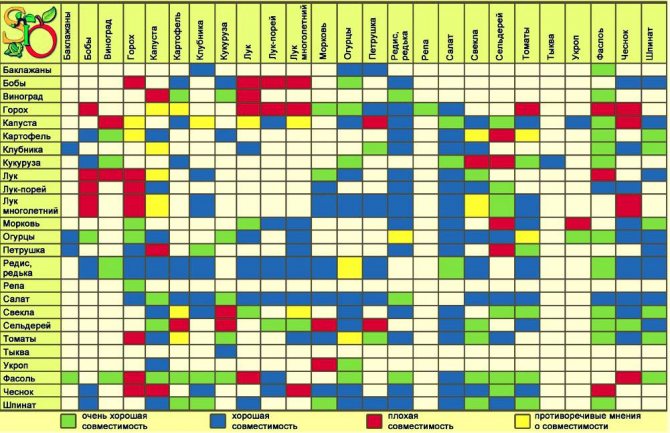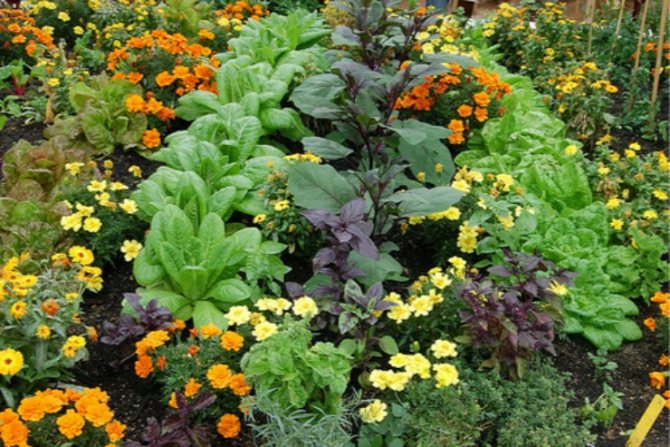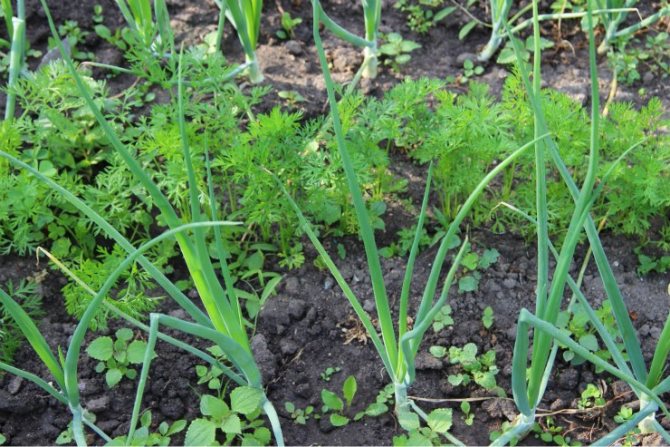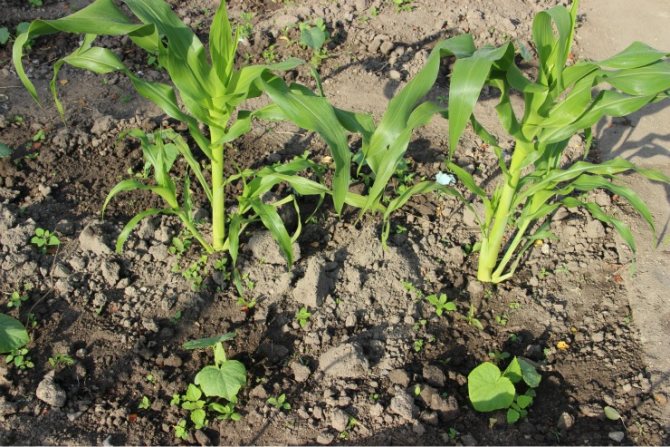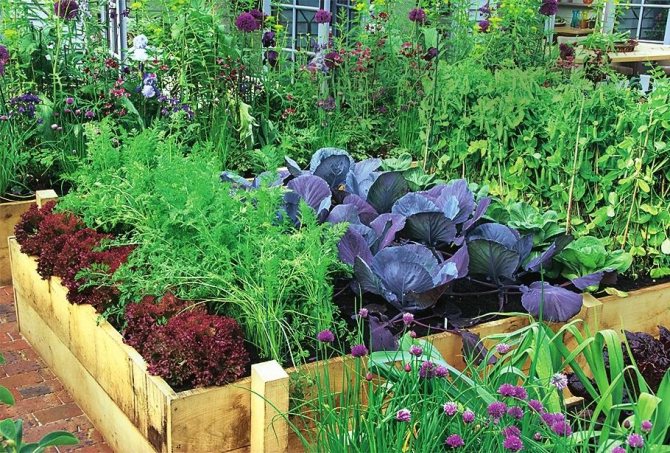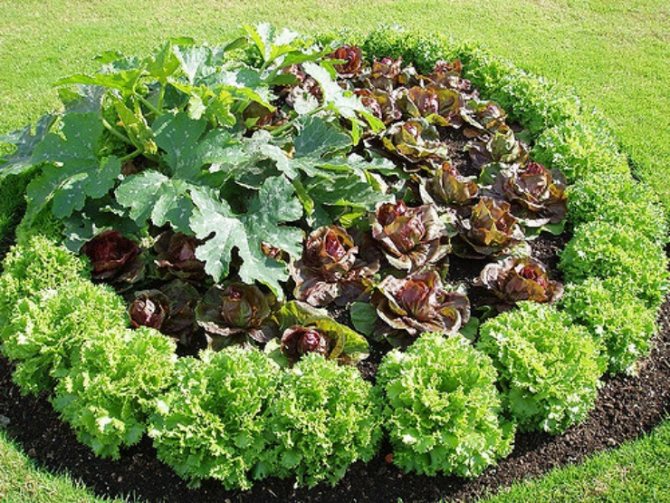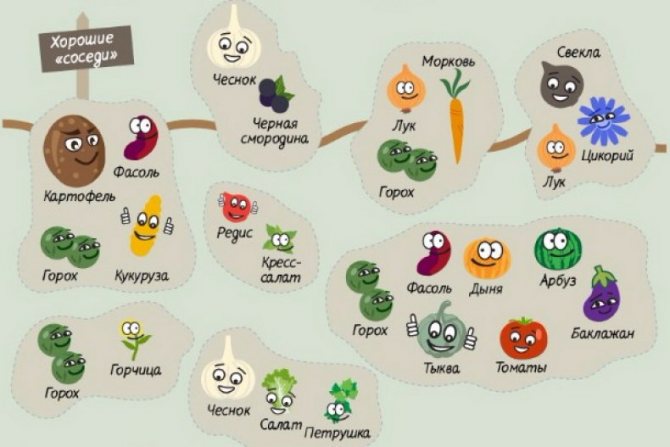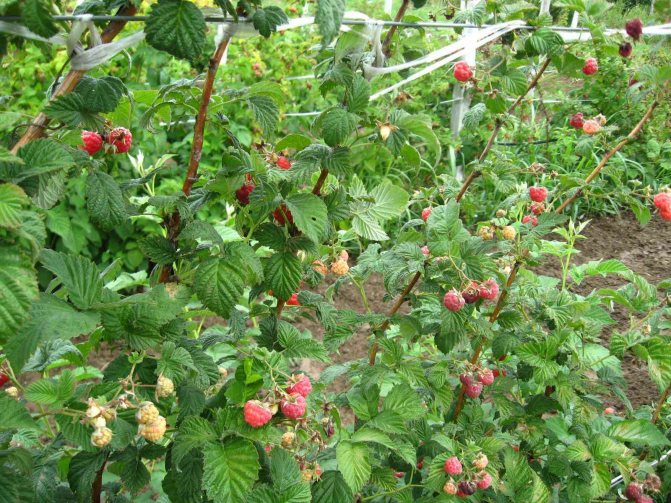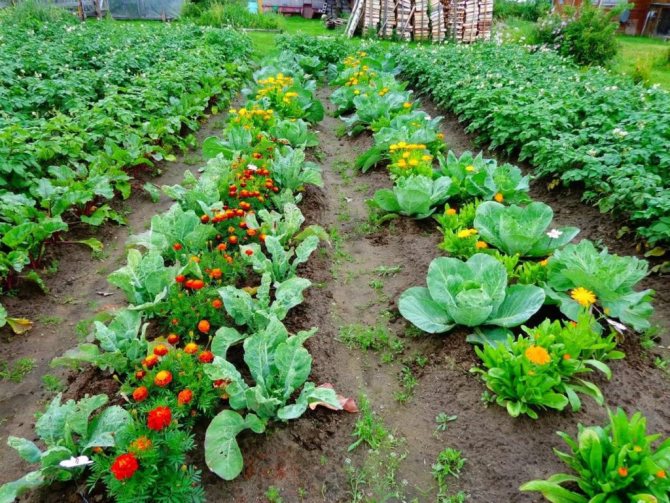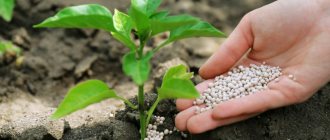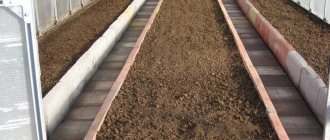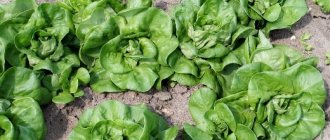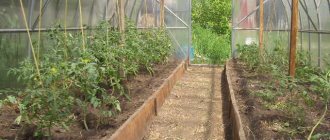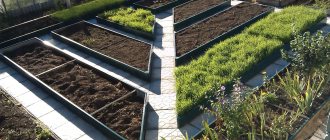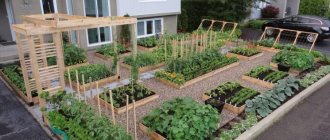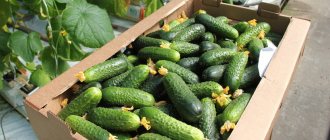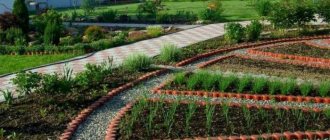When planting vegetables and trees, their features are taken into account - plant growth in the sun or in the shade, abundant or moderate watering, differences in root systems. However, not everyone knows that when planting crops in the garden, their compatibility with each other should be taken into account. Summer residents who grow vegetables know that yield depends not only on favorable conditions and plant care, but also on their location in the beds. Adhering to the rules of compatibility of garden crops, even beginners will be able to rationally use the land and get a good harvest.
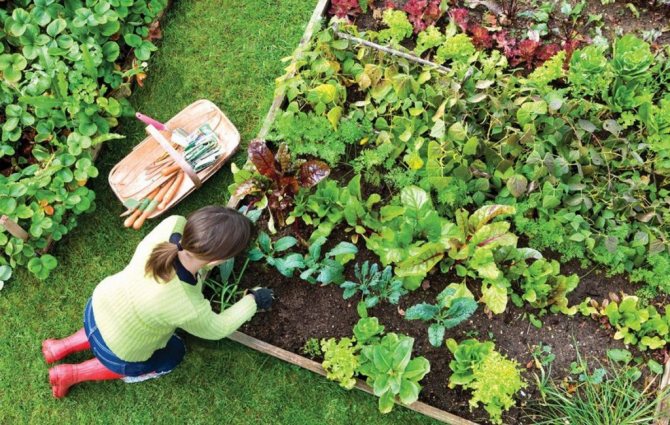
What is a mixed bed?
Joint planting of vegetable crops is not an innovation, but a traditional cultivation of the land, which allows you to get good yields of various products without chemicals. Such agriculture is based on long-term observations of amateur gardeners, when plants are planted on a small plot of land in the neighborhood that have a beneficial effect on each other.
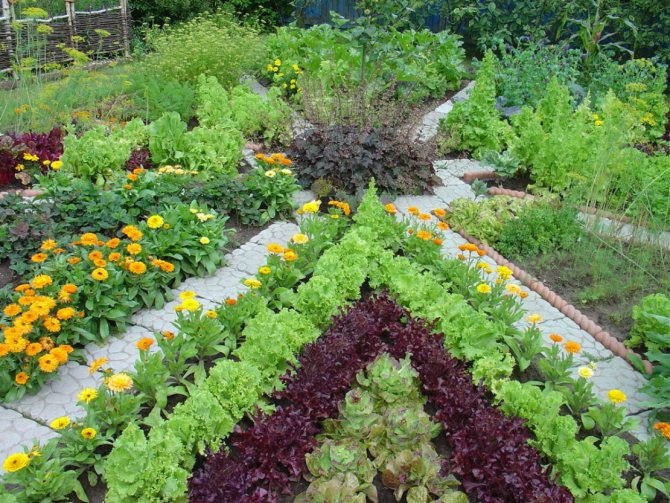

Today it is a whole science, its agricultural techniques are studied within the framework of the allelopathy branch.
It has already been proven that a mixed planting system has a positive effect on the improvement of the soil, does not overwork it due to the observance of crop rotation. The scheme is perfect for a small country house.
Joint cultivation of various vegetables on the same bed in combination with useful herbs allows more economical and efficient use of the land. Well, who would refuse a smart vegetable garden where everything grows in harmony?
Examples of bad neighborhoods not included in the tables
When organizing joint planting of vegetables in the garden, make sure that the gooseberries are away from the currants, otherwise the moth, a pest dangerous for berries, will actively multiply.
A pear planted near a sweet cherry will often hurt. The same situation is observed when planting next to cherries or cherries of any kind of currant. A juniper planted under a pear is more likely to infect it with fungal infections.
The apple tree also loses from the proximity of cherries / cherries, as well as apricots, barberries, lilacs. In general, sweet cherry reacts aggressively to any planting under its crown, especially trees.
A useful neighborhood of cultures and what it gives
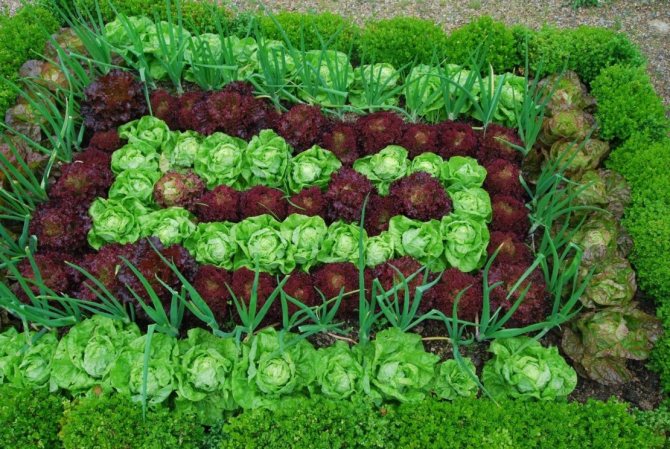

In mixed beds, each crop has its own role. The accompanying plant creates favorable conditions for the development of the main one, protects it from weeds and does not allow moisture to quickly evaporate from the soil.
In addition, while the main vegetable is ripe, another fast-ripening product can be obtained in the garden. Briefly about other benefits of a healthy neighborhood of cultures:
- Reasonable planning will allow you to get fresh vegetables from the garden all season, until late autumn.
- Mixed planting contributes to the mutual improvement of the condition of the plants, and also positively affects the taste and nutritional value of each other's fruits.
- The method reduces the risk of disease in plants and reduces the ability of pests to attack their favorite crop. According to the laws of nature, the right neighborhood ensures self-regulation; insects in such a place will be within reasonable limits, without harm to the inhabitants of the garden.
The greater the variety of crops on the site, the more conditions for creating a natural balance in a single living organism of plants.
Technology advantages
Mixed planting of vegetables in the garden has several advantages over growing crops in isolation:
- the area of the land plot is used as efficiently as possible;
- plants that feed on excellent microelements evenly deplete the soil, not competing with each other;
- neighbors in the garden can improve each other's taste;
- aromas emitted by certain plants can attract or scare away insects;
- the correct arrangement of plants can perform wind protection and create a favorable microclimate for growing specific crops;
- mixed cultivation of vegetables eliminates the use of chemical fertilizers, using only the natural forces of the earth to obtain a good harvest.
Thus, mixed beds are an easy way to improve yields. With the help of this technology, it is possible to competently use the land resources and, without the use of additional funds, attract beneficial pollinating insects, scare off pests and create the necessary microclimatic conditions.
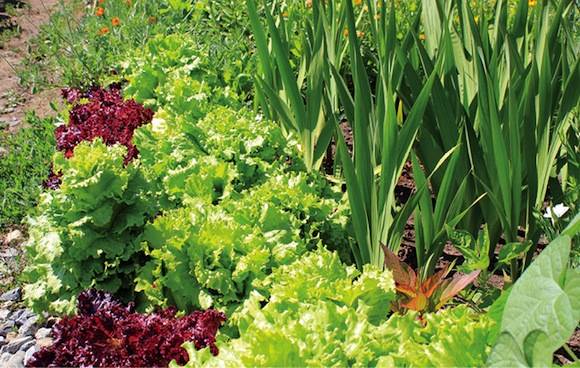

Examples of combined landings
A classic example is the neighborhood of onions and carrots. In such a bed there will be no midges that interfere with the development of each culture in a separate growth. Weeds will not interfere with this friendship of vegetables. The onions are pulled out at the end of summer, the carrots are dug up in the fall.
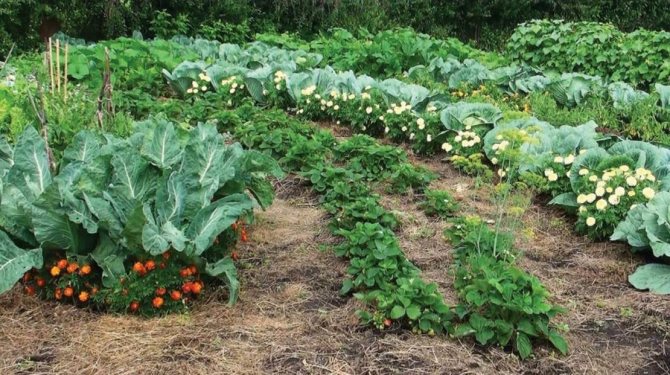

Planting corn, beans and pumpkin is considered ideal. The latter creates a shade for the soil, corn - for lower-growing friends, makes sure that the sun does not scorch them. Beans enrich everyone with nitrogen through the soil.
Summer residents recorded an unusual neighborhood of cucumber with corn or sunflower. A pimply creature in such an alliance finds protection and support, without interfering with her development.
If you want a variety of the first harvest, then plant in a row of radishes, spinach, lettuce and dill on both sides. By the way, early greens are suitable for many crops. You can safely sow it in a company with onions and beets.
How to combine culture in the garden?
Correctly compacted and mixed crops give a yield one and a half to two times higher, without taking away additional efforts from the gardener. Only here you need certain knowledge and a desire to experiment.
How to plant vegetables in mixed beds and increase yields
Foreign farmers are not afraid to use the multicultural method, when they mix plants not only of different species, but also varieties.
Adopting this experience, you can wisely use the remnants of the land after the construction of a house, utility outbuildings, playgrounds, recreation areas and others. Agrotechnical possibilities allow you to mix crops for growing several complementary crops on one bed or to compact the land plot with plants accompanying in terms of sowing and harvesting so as to occupy the entire soil.
With this technology, the crop can be harvested both simultaneously and at different times with a difference of weeks and months. Accordingly, the landing dates will vary. For example, sow lettuce, mustard, onions on a feather, Chinese cabbage, and when the greens grow up, it is time for tomato seedlings.
Or another example: before sowing beets and carrots, you can get a harvest of radish, spinach, lettuce, etc. Why not use it and enrich your body with vitamin greens before the main crop. There are other options for obtaining two or more crops from the garden.
Useful properties of plants
In close proximity to plants requiring pollination, it is recommended to plant crops that attract pollinators. These include various varieties of mint, marjoram, chamomile, thyme, lemon balm. These plants are not vegetables, but can be used for medicinal purposes or as garden decoration. Their scent attracts wasps and predatory flies, which pollinate flowering plants.
Heavy soils require constant loosening. In this case, earthworms can come to the aid of the farmer. To attract them, you can plant onions, chicory, valerian.
Garlic helps fight aphids. Its smell repels these harmful insects. Garlic also contributes to the accumulation of sulfur in the soil.
Important! The above plants, with the exception of garlic, are compatible with absolutely all crops.
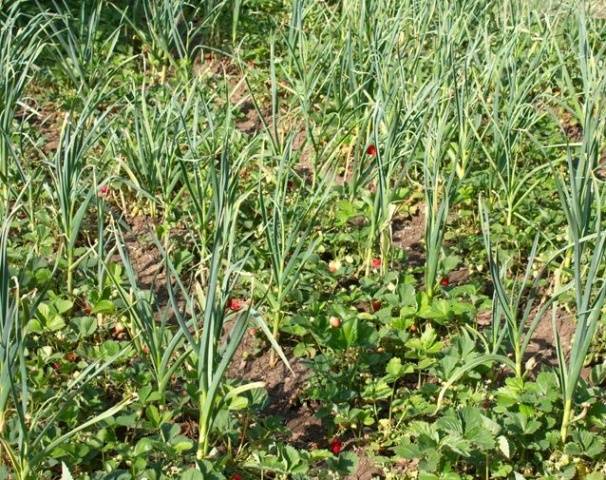

Potato companions
Potato tops are not very sociable for other crops. So, cucumbers, tomatoes, pumpkin, kohlrabi and even a higher plant - a sunflower - will not grow next to it.
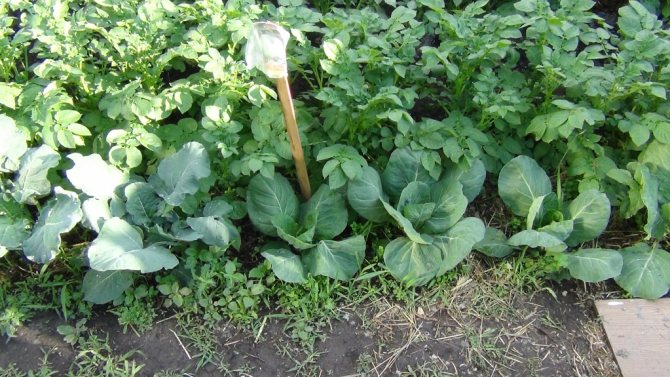

The potato will be a neighbor and will be able to get along:
- with cabbage;
- carrots;
- eggplant;
- corn;
- legumes.
Potatoes are also used as a catch crop in crop rotation. Tubers of an early maturing variety will feel good after the salad. And after harvesting at this place, you can simultaneously grow Chinese cabbage and kohlrabi, placing the bushes in a checkerboard pattern.
Expert opinion
Elena Pchelkina
Horticultural Expert
The former potato plot is a good base for a strawberry or raspberry plantation.
Video: Thickened planting from Galina Kizima
Sowing a garden bed with an additional crop is not at all difficult, you just need to select the appropriate plants and the result will not be long in coming. The use of soil resources will be optimized, yields will increase, and the cultural diversity in the garden will also increase.
Read also: Winter and spring rapeseed as green manure: when and how to sow?
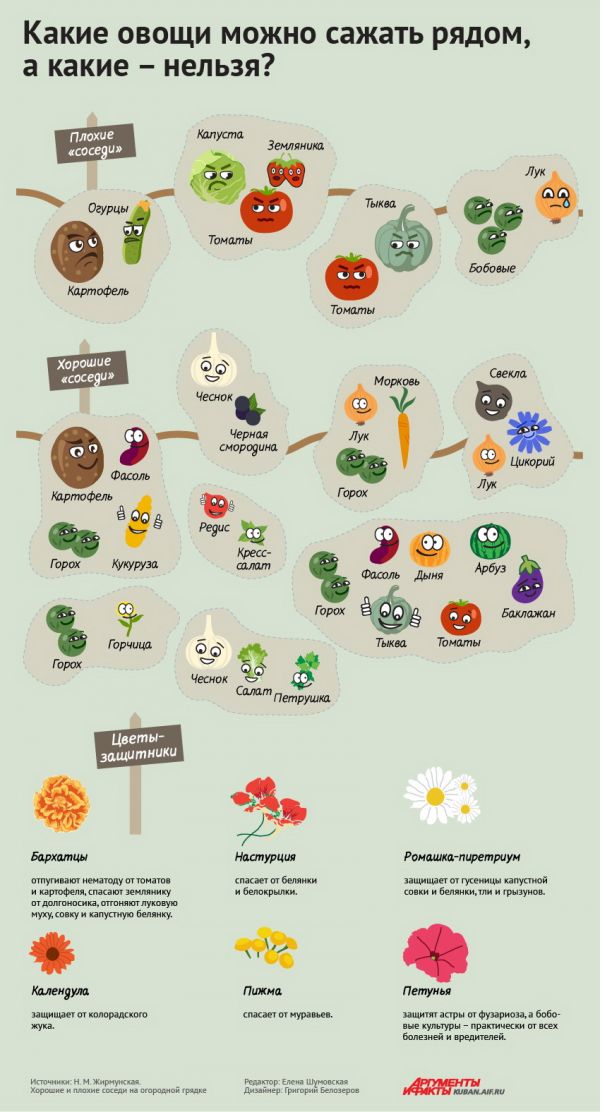

Memo to the gardener: Which vegetables can be planted nearby, and which cannot
Consolidated seeding also helps to spend less time on agricultural work. In addition to vegetables, you can also use ornamental flower plants that will transform the area with their rainbow flowers.
What to plant with cucumbers and tomatoes?
The pumpkin family, which includes cucumbers, will be friendly to the following neighbors:
- eggplant;
- garlic;
- legumes;
- cabbage;
- dill;
- onion.
Cucumbers will not tolerate spicy herbs near them.
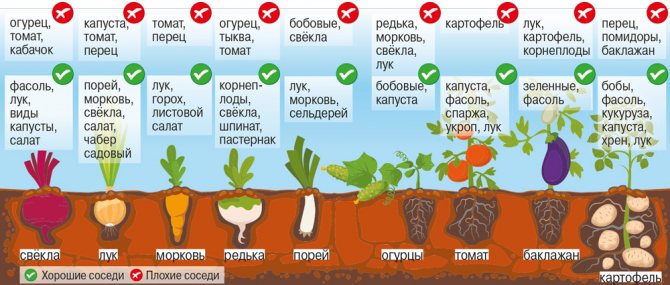

Tomatoes will give an excellent harvest in combination with three plants at once. Lettuce, spinach and radish will not interfere with tomato bushes if they are planted between two rows without gaps in this way: tomato seedlings - lettuce greens - spinach - radishes - again tomatoes.
The main culture will develop well in a company with:
- beans;
- carrots;
- mint;
- basil;
- celery;
- parsley.
Cucumber grass between tomatoes will keep pests away. On one site, you can grow tomatoes and cucumbers at the same time, alternating their rows, and sow marigolds between them.
Secrets of combating late blight in the greenhouse from experienced summer residents
Flowers will enrich the land with the necessary microelements, and will become a bait for pollinators - beneficial insects, by their work, will increase the productivity of the main crops.
What else can you plant together
Knowledge of agricultural technology in other crops will help to optimize the area while achieving the cultivation of more plants.
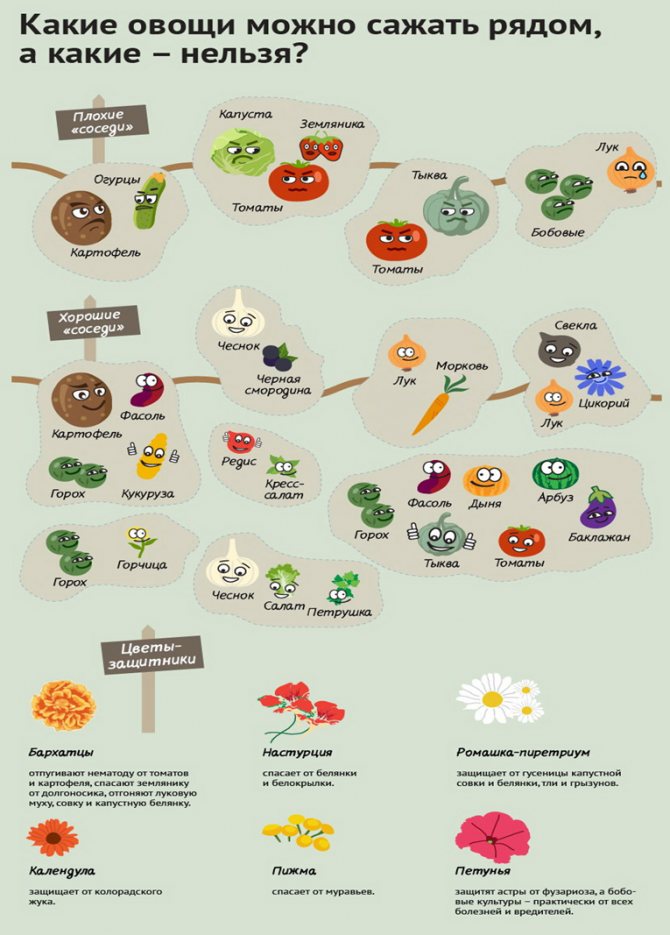

The main rule is that the main species occupies 60% of the site, and the rest should have different ripening periods.
Cabbage
The main enemy of cabbage is pests, therefore it is protected by onions and garlic from a voracious caterpillar, and a butterfly will not approach the heads of cabbage if it smells mint, sage, and other fragrant herbs. The cucumber herb and celery in this company fight back snails and earthen fleas.
Cabbage adjoins well with potatoes, salads, cucumbers, beets. Do not plant it next to strawberries, tomatoes, beans, carrots, grapes.
Beet
Mint and catnip will rid the beets of aphids and flea infestations. A bright root vegetable is friends with white cabbage, carrots, onions, celery, strawberries. But in this case, you should not make the beds too thick, everyone needs a place.Unfriendly neighborhood of beets with legumes, potatoes, mustard.
Pepper (bulgarian) and eggplant
Basil will become an active assistant in the development of bell pepper. Onions and beets will benefit. For carrots, legumes, it is better to find another place.
Eggplants make good friends with beans. Such a perfect union will not be able to destroy the Colorado beetles. Fleas won't come close if there is thyme nearby. Nearby, you can make a place for onions (turnips), peppers, herbs, but not for cucumbers and cabbage.
Garlic
A healthy nutritious product not only benefits humans, but also protects other vegetables from pests. His huge contribution to the fight against insects, caterpillars, slugs, moles. Radishes, lettuce, carrots, strawberries, celery can become his friends in the garden, but the neighborhood with legumes will not be tied.
How weeds help garden plants or the benefits of weeds
It turns out that some weeds can benefit cultivated garden plants. Even the ancient Indians noticed that the gorse - a malicious weed in our gardens, can share with some plants the nutrients it receives from the depths of the soil.
There is, for example, such an opinion that one should not weed out the whole assortment of potatoes, leaving 3-5 plants for each square meter. Having no competitors nearby, the beetle grows, its powerful root system, penetrating deep into the soil, extracts nutrients there - phosphorus, potassium, calcium, of which there are much more at depth than in the upper layers. Excess of these elements are released through the roots into the soil, nourishing the potatoes. That is, the squid, as it were, shares these surpluses with the potatoes. Moreover, these nutrients are in an assimilable form, easily absorbed, assimilated by potatoes.
Scientists-agronomists have already established by laboratory experiments that, in fact, plants can share their root secretions with each other. I must say that plants do not skimp on root secretions - this is very important for them. It has been established that approximately 20% of what is synthesized in plant leaves is excreted by their roots into the soil.
Recently, the question of the benefits and harms of weeds has been significantly revised. If you do not allow weeds to grow uncontrollably, drown out cultivated plants, especially in the early stages of growth, then they can play the role of a useful member of the plant community.
By the way, I noticed that sow thistle - a malicious weed - distracts aphids. Cucumbers grew in my greenhouse. They grew up well. They were healthy. The harvest was good. In the corner of the greenhouse a sow thistle grew - I did not immediately notice him, Only then did I pay attention to him, when he grew more than a meter tall, he even threw out the buds. I decided to uproot it. She gasped when she saw that he was covered with aphids. Here it is, I think, a breeding ground for pests - it must be destroyed. And what? Not even a day after that, as all my, healthy until now, cucumbers were covered with aphids. I had to take measures to destroy the aphids. It turns out that the sow thistle protected my plants from aphids.
I never pull out all the weeds on tomatoes that are planted outdoors. I do weeding only in the first growing season, when there is a danger that the weeds will clog the tomatoes and cover them from the sun. But when my tomatoes gain strength, they are not afraid of weeds. They shelter the soil from the burning sun - it does not crust over, does not dry out, you can water less often. In addition, grass and weeds protect fruits from sunburn, which is very important in our hot southern climate.
Most weeds have a deep root system. In the struggle for existence, they have developed the habit of getting food deep in the soil. In cultivated plants, which we indulge in our care, this ability is rare.
The most important vegetable plants, such as potatoes, corn, cabbage lettuce, cucumbers and a number of others, have a shallow root system and are fed from the upper layers of the soil. And, for example, a dandelion with its powerful root system extracts calcium from the depths. In addition, this weed plant releases a large amount of ethylene gas into the air, which accelerates the ripening of fruits, not to mention the fact that its bright flowers attract bees and other pollinating insects to the garden.
Vegetable friendship table
To organize mixed plantings in a small area, you need to take into account the properties and needs of the plants, and it is also good to know what is combined with what.
It is convenient to consider the joint landing schemes in the table:
| Culture | Companions |
| Beans | Cucumbers, corn, cabbage, beets |
| White cabbage | Onions, mint, sage, dill, celery, cucumber herb |
| Potatoes | Legumes, cabbage, radishes, salads, coriander, marigolds |
| Cucumbers | Peas, beans, cabbage, beans |
| Basil | Tomatoes, lettuce and other all crops |
| Carrot | Onions, dill, lettuce, sage |
| Eggplant | Beans, thyme |
| Corn | Cucumber, zucchini |
| Pumpkin | Legumes, corn |
| Tomatoes | Celery, spinach, beans, carrots |
| Beet | Cucumbers, cabbage, garlic, celery |
| Onion | Radishes, cucumbers, carrots, strawberries |
| Radish | Beans, salads, garlic, peas, onions |
| Peas | Cucumbers, radishes, carrots |
| Garlic | Tomato, cucumber, beetroot, strawberry |
| Spinach | All cultures |
| Celery | Cabbage, beans, peas, soybeans, cucumber |
| Strawberry | Spinach, sage, parsley, pumpkin |
| Grapes | Corn, potatoes, radish, rye, beans |
Neighborhood rules for vegetables for greenhouses
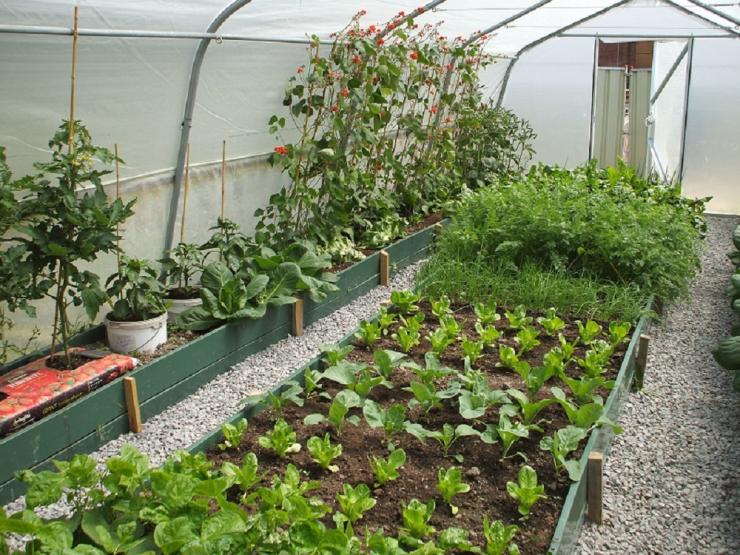

If you are interested in the compatibility of vegetable crops when planting in a greenhouse, keep in mind the following factors:
- in greenhouses, vegetables grow earlier, and in general, the harvest becomes better;
- in order to properly plant vegetables in the greenhouse, it is necessary to follow the same principles as in the open field;
- before disembarking, it is necessary to carefully develop a plan for the beds;
- it is necessary to take into account the cardinal points - cucumbers and tomatoes grow more reliably on the sunny south side.
The planting compatibility in the greenhouse garden bed is closely connected with the season. There are 2 types of mixed greenhouse planting. In the 1st, the greens are grown in early spring, in the 2nd - a variety of crops are cultivated during the season. In other words, at first, greens are planted, which ripens quite quickly, after which they are harvested and planted in the same place with tomatoes or cucumbers.
In the greenhouse, it is recommended to plant those plantings, which require similar conditions of humidity and temperature. Cucumbers give a rich shade, for this reason, it is possible to place photo-sensitive crops next to them. Tomatoes will feel great with white cabbage.
Mixed planting of vegetables can help to get a good harvest even in difficult situations - bad land, inappropriate climate. It is possible to combine mixed beds with a compacted seeding technique to normalize the effect. In short, the formation of your dream garden is in your hands, if you use modern know-how correctly. Both the beginner and the experienced gardener can learn something new from mixed planting technology.
Real reviews of summer residents about mixed plantings
From the editorial board... Mixed plantings are unusual, but the most significant plus is to save space, which is important with a small summer cottage.

